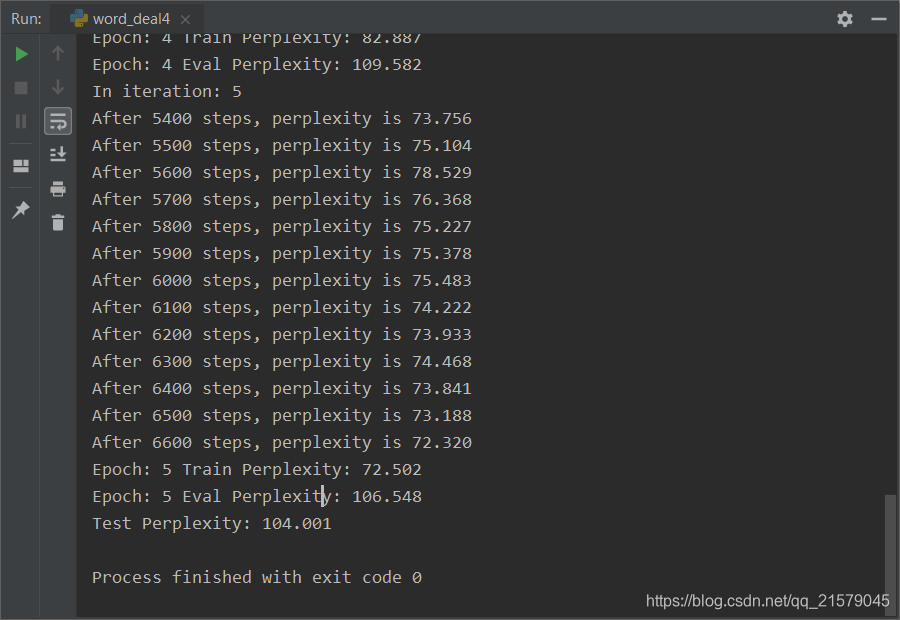参考书
《TensorFlow:实战Google深度学习框架》(第2版)
一个完整的训练程序,它使用一个双层LSTM作为循环神经网络的主体,并共享Softmax层和词向量层的参数。
#!/usr/bin/env python # -*- coding: UTF-8 -*- # coding=utf-8 """ @author: Li Tian @contact: 694317828@qq.com @software: pycharm @file: word_deal4.py @time: 2019/2/25 9:38 @desc: 一个完整的训练程序,它使用一个双层LSTM作为循环神经网络的主体,并共享Softmax层和词向量层的参数。 """ import numpy as np import tensorflow as tf # 训练数据路径 TRAIN_DATA = "ptb.train" # 验证数据路径 EVAL_DATA = "ptb.valid" # 测试数据路径 TEST_DATA = "ptb.test" # 隐藏层规模 HIDDEN_SIZE = 300 # 深层循环神经网络中LSTM结构的层数 NUM_LAYERS = 2 # 词典规模 VOCAB_SIZE = 10000 # 训练数据batch的大小 TRAIN_BATCH_SIZE = 20 # 训练数据截断长度 TRAIN_NUM_STEP = 35 # 测试数据batch的大小 EVAL_BATCH_SIZE = 1 # 测试数据截断长度 EVAL_NUM_STEP = 1 # 使用训练数据的轮数 NUM_EPOCH = 5 # LSTM节点不被dropout的概率 LSTM_KEEP_PROB = 0.9 # 词向量不被dropout的概率 EMBEDDING_KEEP_PROB = 0.9 # 用于控制梯度膨胀的梯度大小上限 MAX_GRAD_NORM = 5 # 在Softmax层和词向量层之间共享参数 SHARE_EMB_AND_SOFTMAX = True # 通过一个PTBModel类来描述模型,这样方便维护循环神经网络中的状态。 class PTBModel(object): def __init__(self, is_training, batch_size, num_steps): # 记录使用的batch大小和截断长度 self.batch_size = batch_size self.num_steps = num_steps # 定义每一步的输入和预期输出。两者的维度都是[batch_size, num_steps] self.input_data = tf.placeholder(tf.int32, [batch_size, num_steps]) self.targets = tf.placeholder(tf.int32, [batch_size, num_steps]) # 定义使用LSTM结构为循环体结构且使用dropout的深层循环神经网络。 dropout_keep_prob = LSTM_KEEP_PROB if is_training else 1.0 lstm_cells = [ tf.nn.rnn_cell.DropoutWrapper(tf.nn.rnn_cell.BasicLSTMCell(HIDDEN_SIZE), output_keep_prob=dropout_keep_prob) for _ in range(NUM_LAYERS) ] cell = tf.nn.rnn_cell.MultiRNNCell(lstm_cells) # 初始化最近的状态,即全零的向量。这个量只在每个epoch初始化第一个batch时使用。 self.initial_state = cell.zero_state(batch_size, tf.float32) # 定义单词的词向量矩阵 embedding = tf.get_variable("embedding", [VOCAB_SIZE, HIDDEN_SIZE]) # 将输入单词转化为词向量 inputs = tf.nn.embedding_lookup(embedding, self.input_data) # 只在训练时使用dropout if is_training: inputs = tf.nn.dropout(inputs, EMBEDDING_KEEP_PROB) # 定义输出列表。在这里先将不同时刻LSTM结构的输出收集起来,再一起提供给softmax层。 outputs = [] state = self.initial_state with tf.variable_scope("RNN"): for time_step in range(num_steps): if time_step > 0: tf.get_variable_scope().reuse_variables() cell_output, state = cell(inputs[:, time_step, :], state) outputs.append(cell_output) # 把输出队列展开成[batch, hidden_size * num_steps]的形状,然后再reshape成[batch*num_steps, hidden_size]的形状。 output = tf.reshape(tf.concat(outputs, 1), [-1, HIDDEN_SIZE]) # Softmax层:将RNN在每个位置上的输出转化为各个单词的logits if SHARE_EMB_AND_SOFTMAX: weight = tf.transpose(embedding) else: weight = tf.get_variable("weight", [HIDDEN_SIZE, VOCAB_SIZE]) bias = tf.get_variable("bias", [VOCAB_SIZE]) logits = tf.matmul(output, weight) + bias # 定义交叉熵损失函数和平均损失 loss = tf.nn.sparse_softmax_cross_entropy_with_logits( labels=tf.reshape(self.targets, [-1]), logits=logits ) self.cost = tf.reduce_sum(loss) / batch_size self.final_state = state # 只在训练模型时定义反向传播操作 if not is_training: return trainable_variables = tf.trainable_variables() # 控制梯度大小,定义优化方法和训练步骤 grads, _ = tf.clip_by_global_norm(tf.gradients(self.cost, trainable_variables), MAX_GRAD_NORM) optimizer = tf.train.GradientDescentOptimizer(learning_rate=1.0) self.train_op = optimizer.apply_gradients(zip(grads, trainable_variables)) # 使用给定的模型model在数据data上运行train_op并返回在全部数据上的perplexity值 def run_epoch(session, model, batches, train_op, output_log, step): # 计算平均perplexity的辅助变量 total_costs = 0.0 iters = 0 state = session.run(model.initial_state) # 训练一个epoch for x, y in batches: # 在当前batch上运行train_op并计算损失值。交叉熵损失函数计算的就是下一个单词为给定单词的概率 cost, state, _ = session.run( [model.cost, model.final_state, train_op], {model.input_data: x, model.targets: y, model.initial_state: state} ) total_costs += cost iters += model.num_steps # 只有在训练时输出日志 if output_log and step % 100 == 0: print("After %d steps, perplexity is %.3f" % (step, np.exp(total_costs / iters))) step += 1 # 返回给定模型在给定数据上的perplexity值 return step, np.exp(total_costs / iters) # 从文件中读取数据,并返回包含单词编号的数组 def read_data(file_path): with open(file_path, "r") as fin: # 将整个文档读进一个长字符串 id_string = ' '.join([line.strip() for line in fin.readlines()]) # 将读取的单词编号转为整数 id_list = [int(w) for w in id_string.split()] return id_list def make_batches(id_list, batch_size, num_step): # batch_size: 一个batch中样本的数量 # num_batches:batch的个数 # num_step: 一个样本的序列长度 # 计算总的batch数量。每个batch包含的单词数量是batch_size * num_step num_batches = (len(id_list) - 1) // (batch_size * num_step) # 将数据整理成一个维度为[batch_size, num_batches*num_step]的二维数组 data = np.array(id_list[: num_batches * batch_size * num_step]) data = np.reshape(data, [batch_size, num_batches * num_step]) # 沿着第二个维度将数据切分成num_batches个batch,存入一个数组。 data_batches = np.split(data, num_batches, axis=1) # 重复上述操作,但是每个位置向右移动一位,这里得到的是RNN每一步输出所需要预测的下一个单词 label = np.array(id_list[1: num_batches * batch_size * num_step + 1]) label = np.reshape(label, [batch_size, num_batches * num_step]) label_batches = np.split(label, num_batches, axis=1) # 返回一个长度为num_batches的数组,其中每一项包括一个data矩阵和一个label矩阵 # print(len(id_list)) # print(num_batches * batch_size * num_step) return list(zip(data_batches, label_batches)) def main(): # 定义初始化函数 initializer = tf.random_uniform_initializer(-0.05, 0.05) # 定义训练用的循环神经网络模型 with tf.variable_scope("language_model", reuse=None, initializer=initializer): train_model = PTBModel(True, TRAIN_BATCH_SIZE, TRAIN_NUM_STEP) # 定义测试用的循环神经网络模型。它与train_model共用参数,但是没有dropout with tf.variable_scope("language_model", reuse=True, initializer=initializer): eval_model = PTBModel(False, EVAL_BATCH_SIZE, EVAL_NUM_STEP) # 训练模型 with tf.Session() as session: tf.global_variables_initializer().run() train_batches = make_batches(read_data(TRAIN_DATA), TRAIN_BATCH_SIZE, TRAIN_NUM_STEP) eval_batches = make_batches(read_data(EVAL_DATA), EVAL_BATCH_SIZE, EVAL_NUM_STEP) test_batches = make_batches(read_data(TEST_DATA), EVAL_BATCH_SIZE, EVAL_NUM_STEP) step = 0 for i in range(NUM_EPOCH): print("In iteration: %d" % (i + 1)) step, train_pplx = run_epoch(session, train_model, train_batches, train_model.train_op, True, step) print("Epoch: %d Train Perplexity: %.3f" % (i + 1, train_pplx)) _, eval_pplx = run_epoch(session, eval_model, eval_batches, tf.no_op(), False, 0) print("Epoch: %d Eval Perplexity: %.3f" % (i + 1, eval_pplx)) _, test_pplx = run_epoch(session, eval_model, test_batches, tf.no_op(), False, 0) print("Test Perplexity: %.3f" % test_pplx) if __name__ == '__main__': main()
运行结果:
